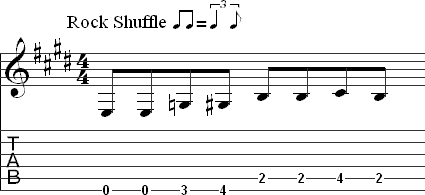What You Should Know
What You Will Learn
Counting and Playing Swing Rhythms
In some styles of music it is common to play eighth notes in a pattern of long-short rhythms rather than playing the rhythms as notated. This is known as a swung rhythm. Swung eighth notes are found in many styles, including rock, blues, and jazz.
Some music may include eighth notes that are played normally in addition to the swung eighth notes. Eighth notes that aren't swung are often called straight eighths to distinguish them from swung eighth notes.
If swung eighth notes are indicated, all rhythmic values other than eighth notes will generally be unaffected and played normally.
Long / Short Rhythms
The pattern of long and short notes in swung eighth notes isn't clearly defined. It's often more about feel than playing an exact rhythm. However, the long/short rhythmic pattern will generally be close to one of two rhythms:
Rhythm One
The first long/short pattern is a quarter note triplet followed by an eighth note triplet:

Rhythm Two
The other common pattern is a dotted eighth note paired with a sixteenth note:

If you think about the long/short patterns in terms of ratios, it may make more sense. Straight eighths would be 1:1. The first rhythm above would be a 2:1 ratio, while the second would be 3:1. The first number in the ratio represents the long note value and the second number indicates the short value. For example 3:1 means that the long note value is three times longer than the short value (i.e., a dotted eighth paired with a sixteenth note).
Hearing the Difference Between Straight and Swung Eighths
Below are two audio examples of the same guitar riff. The riff is a common blues boogie bass accompaniment pattern that may be played straight or swung depending on the player. Listen closely to the rhythm in both clips. Do you hear the difference between the straight and swung examples?
| Description | Audio |
|---|---|
| straight eighths | |
| swung eighths |
Notating Swung Eighth Notes
Swung eighths are generally notated as regular eighth notes with an indication at the beginning of a piece or section that is to be played with swung eighths:

This indication can be canceled by using the following notation:

Some music may use textual indications instead of or in addition to the symbols above. Common examples of this include "Swing" and "Shuffle." Below is an example of a textual indication used with a symbol:

Compound Time Signatures
Swung rhythms may occasionally be written in a compound time signature as shown below:

Counting Swung Eighth Notes
Swung eighth notes can be counted by counting as you would for regular eighth notes, but shifting the 'and' of the beat so that the rhythm approximates the rhythms given above.
